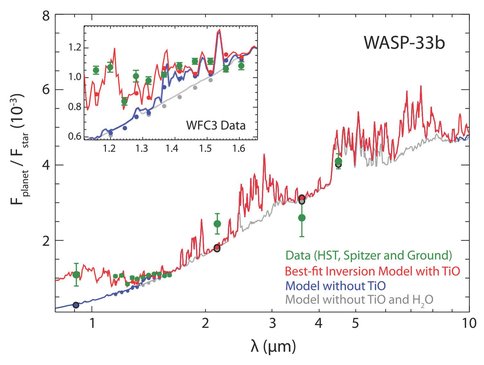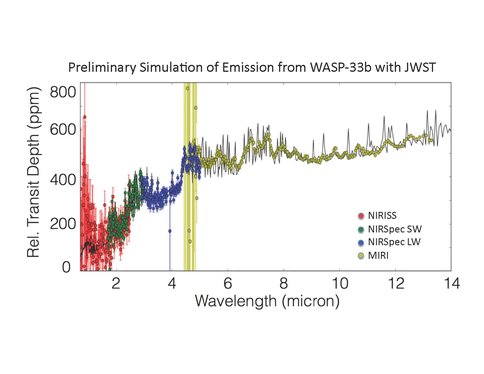2015 Annual Science Report
 NASA Goddard Space Flight Center
Reporting | JAN 2015 – DEC 2015
NASA Goddard Space Flight Center
Reporting | JAN 2015 – DEC 2015
Exploring the Structure and Composition of Exoplanets With Current and Future Telescopes
Project Summary
This project addresses a major frontier of planetary science and astrobiology, namely the identification and characterization of habitable (and inhabited) exoplanets. Measurements of molecular absorption in the atmospheres of these planets offer the chance to explore several outstanding questions regarding the atmospheric structure and composition of hot Jupiters. Targeted questions include the possibility of bulk compositional variations among planets, and the presence or absence of a stratospheric temperature inversion on individual planets. In this reporting period, we emphasized four areas:
1. We improved our modeling and analysis of exoplanet transit and eclipse measurements obtained with the Hubble Space Telescope (HST) and the Spitzer Space Telescope on highly irradiated, Jupiter-mass planets.
2. We improved our data analysis methods to better understand aspects of measuring the chemical composition of the planet’s atmosphere, and we advanced the chemical and thermal modeling of the planet’s hot dayside.
3. We developed simulations of future observations with the James Webb Space Telescope (JWST), and we provided science leadership for a future balloon-borne telescope that can perform transit spectroscopy of hot exoplanet atmospheres.
4. We estimated the discovery yield of future Earth-like exoplanet imaging missions as part of the planning process for the next Astrophysics Decadal Survey, and we are now expanding this effort to estimate the science yield from spectroscopic characterization of them.
Project Progress
In this reporting period, we published our analysis of thermal emission from WASP-33b, one of the hottest exoplanets known. This massive hot planet provides the best opportunity to determine whether stratospheric temperature inversions exist in Jupiter-mass planets – a key factor in interpreting their spectra and determining their composition. The final results strongly suggest the presence of water emission at 1.4 µm due to a thermal inversion as well as emission from TiO at shorter wavelengths, making WASP-33b the first planet with a spectrally confirmed inversion (see Figure 1).
In collaboration with Klaus Pontoppidan at the Space Telescope Science Institute (STScI), we advanced a set of simulation algorithms to leverage the current progress on the official JWST Exposure Time Calculator (ETC). The simulator will incorporate up-to-date information for each instrument, and will be made public online at the same time as the official ETC. The web portal is currently in the testing phase, and we are preparing a scientific paper using the simulator to examine the planets that are most amenable to characterization at different wavelengths (see Figure 2).
We advanced the design and planning stages for a balloon-borne telescope for planetary science including exoplanet characterization, called the Gondola for High Altitude Planetary Science (GHAPS). The project is led by Glenn Research Center with GSFC as the science lead. It will provide an excellent opportunity to conduct surveys of hot exoplanets during long-duration balloon flights in the Southern Hemisphere.
Finally, we conducted simulations of the potential for imaging and spectroscopy of Earth-like planets with the next generation of space-based telescopes. JWST, WFIRST, and the flagship UVOIR space telescopes in future decades will enable revolutionary high-contrast imaging of exoplanets, and we have developed an “exoplanet imaging yield calculator” to determine how many exoplanets of different sizes will be detectable with future observatories (Stark et al. 2015; ibid. 2016 submitted). We are now working on metrics that quantify the ability of different observatory architectures to characterize planets using spectroscopy at visible and NIR wavelengths.
Publications
-
Angerhausen, D., Mandushev, G., Mandell, A., Dunham, E., Becklin, E., Collins, P., … Wolf, J. (2015). First exoplanet transit observation with the Stratospheric Observatory For Infrared Astronomy: confirmation of Rayleigh scattering in HD 189733 b with the High-Speed Imaging Photometer for Occultations. Journal of Astronomical Telescopes, Instruments, and Systems, 1(3), 034002. doi:10.1117/1.jatis.1.3.034002
- Haynes, K., Mandell, A. M., Madhusudhan, N., Deming, D., & Knutson, H. (2015). Spectroscopic evidence for a temperature inversion in the dayside atmosphere of hot-Jupiter WASP-33b. The Astrophysical Journal, 806(2), 146. doi:10.1088/0004-637x/806/2/146
- Stark, C. C., Roberge, A., Mandell, A., Clampin, M., Domagal-Goldman, S. D., McElwain, M. W., & Stapelfeldt, K. R. (2015). Lower limits on aperture size for an ExoEarth-detecting coronagraphic mission. The Astrophysical Journal, 808(2), 149. doi:10.1088/0004-637x/808/2/149
-
PROJECT INVESTIGATORS:
-
PROJECT MEMBERS:
Daniel Angerhausen
Collaborator
Natasha Batalha
Collaborator
Sarah Blumenthal
Collaborator
Drake Deming
Collaborator
Shawn Domagal-Goldman
Collaborator
Eric Hebrard
Collaborator
Terry Hurford
Collaborator
Klaus Pontoppidan
Collaborator
Aki Roberge
Collaborator
Chris Stark
Collaborator
Hannah Wakeford
Collaborator
-
RELATED OBJECTIVES:
Objective 1.1
Formation and evolution of habitable planets.
Objective 1.2
Indirect and direct astronomical observations of extrasolar habitable planets.
Objective 7.2
Biosignatures to be sought in nearby planetary systems


